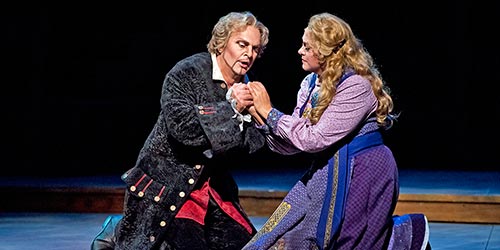By Michael H. Margolin

Richard Wagner's "The Flying Dutchman" is a problem opera with its stillborn plot and its slow first act. Still, it has ardent supporters - not those who left after Act I, but the wildly cheering ones who applauded at its end.
The applause for MOT's David Dichiera when he announced Ford Motor Company's underwriting in his traditional curtain speech was also lusty, perhaps a sign that some feel hope now that our moribund economy may be revived.
Last staged here some 16 years ago, "Dutchman" is one of Wagner's early operas. It debuted in 1843 and is classified as a Romantic opera. While through-composed with recurring leitmotifs, it does stop for some arias; it would be later in his career that Wagner would find the key to his own personal chromaticism and his long, through-composed works - such as the "Ring Cycle" - currently performed, revered and much compared in opera houses in America and Europe.
"Moby Dick" that was published just a few years later reflects some of the same themes, though in a much more complex fashion - the sailing ship, the obsessed captain who is doomed, on a voyage to seek an end to his obsession. And the current film with Robert Redford, "All is Lost," deals with the theme of man against nature, a more modern, late Romantic notion of man's destiny. So there is a long link between Wagner's opera and the notions of damned humans waging war against devils by different names.
But the Dutchman is redeemed. The story takes place in Norway, 1700s, when the Dutchman's ship veers off course and he comes on land - as he does every seven years. One of those time s just happened to be last night.
The Dutchman has made a pact with the devil while traveling around the treacherous Cape of Good Hope (irony) and his ship's sails are colored red (symbolic); he can be released by a good woman who will be absolutely faithful in her love (goodness=godness). (There is some melodramatic goofiness about the crew being ghosts and scaring the bejesus out of the villagers who haul out the welcome baskets, but in this production it seems silly.)
Senta is that woman, and she has been prepared all her life for this: In the prologue we see her at three ages, and each one features a ship with red sails that she plays with, getting larger in each episode - she and the toy. Above and behind, a looming portrait of the Dutchman, which turns out to be in the home of Senta and her father (fate), who is willing to marry her off to the Dutchman - for a hunk of moola, it is said, by Senta's rejected suitor, Erik.
While not explicit, it is my best guess that the story of the Dutchman is a kind of folktale, understood and accepted by generations. Why else a portrait of him? However, the leap to reality is, of course, a leap of faith.
That's about it, so what one needs is some great music and some terrific singing. There was enough of that on Saturday night to make it a go.
In the role of the Dutchman, Thomas Gazheli brought a certain imperious intensity to the role. In the first act he seemed distant, ghostlike, almost barking his vocalizations, warming up vocally in Act Two in his duet with Senta, and in the final act, singing his doomed heart out - thinking he has been betrayed.
When we finally hear Senta, she is sitting among a group of fisherman-wives-sweethearts, singing and repairing nets. Senta, sung by Lori Phillips, seems drunk, even catatonic, but then we see this is the obsession with the Dutchman and the portrait. (It is also similar to "The Tales of Hoffman" when Antonia sings herself to death with her mother's portrait as a co-conspirator.) She tells the women to stop singing in a petulant way. (I don't blame her, the tune they sing is thin and saccharine - something that a later Romantic composer like a Saint-Saens would have turned into a lush melody.)
Phillips' voice is pliant, fierce at the top, colorful, vibrant, a top-notch young voice. Her performance is, at first, almost robotic, and I think that works quite well to underpin the kind of mindset she has. She is a woman straining at the leash, yearning to break out of the boredom of the humdrum fishing village and into the arms of the Dutchman and into an orgasm of idealized love. This production could be renamed "Senta" based on her performance and updated for Lifetime television.
Two tenors are also new to MOT. As the steersman on the ship owned by Daland, Senta's father, which makes contact with the red-sailed ship, Daniel Shirley has a lithe, high tenor voice, and though it is not ideally suited to this role, he acquits himself well. As Senta's castaway, Erik, John Pickle sang with great feeling, his voice veering from the lyric to the dramatic with ease - and he has good looks to boot.
As Daland, Burak Bilgili - a wonderful Leporello in 2010 - sang well, but this role is too bland for his buoyant and likable stage personality; Daland is a downer.
As Mary, Danielle Wright did not bring much more to the role - which is no more than a plot device - than necessary.
About this production, conceived for Lyric Opera of Kansas City, there are arresting moments and some clunky ones.
During the musical prologue to the first act there is music that is one of the top 10 Wagner melodies. On the screen across the stage front, a projection of the two ships, Daland's and the Dutchman's in stormy waters. It looks like a good idea, but after awhile, one began to wonder, are there credits?
The pantomime scenes are clunky and unclear. What the heck is Mary whispering into Senta's ear before she snatches the doll and gives her the toy ship with red sails? "Here's your fate, honey, just wait until the next act?"
And in the last act, when Senta yearns toward the Dutchman, why does she have to be limply restrained? The obsessed energy should be enough to keep others away, like Carrie's force field that propels people through the air.
The newly conceived ending, however, is a beaut. Without giving anything away, I will just say that instead of tossing herself off the cliff (as "Tosca" does at the end of her eponymous role) after Dutch has sailed away, there is a much more Romantic ending.
Bernard Uzan, the director, has produced some fine staging at MOT, especially the re-imagined one-act "Cavalleria Rusticana" into a two acter that included a very good original pantomime sequence. So why the clumsy pantomime? And why is the stage action between Senta and the Dutchman so sloppy?
From the original production, Donald Thomas' lighting design is effective both dramatically and visually, nicely tethered to R. Keith Brumley's set design, and Mary Traylor's costumes respect the vernacular.
As for the music, the charismatic Steven Mercurio, an MOT stalwart, led the MOT Orchestra. The brasses and horns were eloquent, and the sound from the pit, on the whole, was luxurious. Suzanne Mallare Acton's leadership of the chorus, and the chorus, were great assets.
For Wagnerites, there were many things to make this a must-see; for others, there was high caliber singing, fine, new voices, iconic Wagner sound. Just don't let the first act scare you off.
REVIEW:
'The Flying Dutchman'
Michigan Opera Theatre at Detroit Opera House, 1526 Broadway St., Detroit. 7:30 p.m. Oct. 23, 25, 26 and 2:30 p.m. Oct. 27. 3 hours. $25-125. 313-237-SING. http://www.motopera.org









